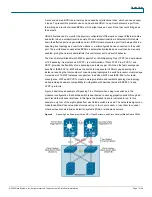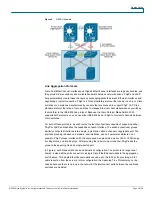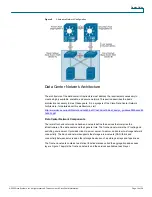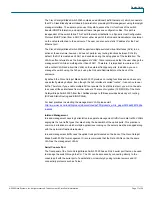
Design Guide
© 2008 Cisco Systems, Inc. All rights reserved. This document is Cisco Public Information.
Page 21 of 28
RSPAN requires a VLAN to carry the mirrored traffic to the remote destination switch. In the
recommended topology, the secondary aggregation switch is the RSPAN destination, where an
analysis device, such as the integrated Cisco Network Analysis Module (NAM), resides. The
RSPAN VLAN uses the uplink between the blade switch and the secondary aggregation switch.
This uplink is blocking under normal conditions for regular VLANs. As a result, bandwidth usage is
a concern only when the uplink is forwarding and sharing the path with production traffic.
Configuring the Aggregate Switches
Complete the following steps on the aggregate switches:
Step 1. VLAN configuration
Step 2. RPVST+ configuration
Step 3. Primary and secondary root configuration
Step 4. Configuration of port channels between aggregate switches
Step 5. Configuration of port channels between aggregate switches and Cisco Catalyst Blade
Switch 3020s
Step 6. Trunking of port channels between aggregate switches
Step 7. Configuration of default gateway for each VLAN
Note:
The “Configuration Details” section describes each of these steps.
Configuring the Cisco Catalyst Blade Switch 3020s
Complete the following steps on the Cisco Catalyst Blade Switch 3020s:
Step 1. VLAN configuration
Step 2. RPVST+ configuration
Step 3. Configuration of port channels between the Cisco Catalyst Blade Switch 3020 and
aggregate switches
Step 4. Trunking of port channels between the Cisco Catalyst Blade Switch 3020 and aggregate
switches
Step 5. Configuration of server ports on the Cisco Catalyst Blade Switch 3020
Additional Aggregation-Switch Configuration
The following recommendations help integrate the Cisco Catalyst Blade Switch 3020s into the data
center:
Step 1. Enable Root Guard on the aggregate-switch links connected to the switches in the blade
enclosure.
The spanning-tree topology is calculated, and one of the primary parameters involved in
this equation is the location of the root switch. Determining the position of the root switch
in the network allows the network administrator to create an optimized forwarding path for
traffic. The Root Guard feature is designed to control the location of the root switch.
The aggregation switches should employ the spanning-tree guard root command on the
port-channel interfaces connected to the blade switches.








































